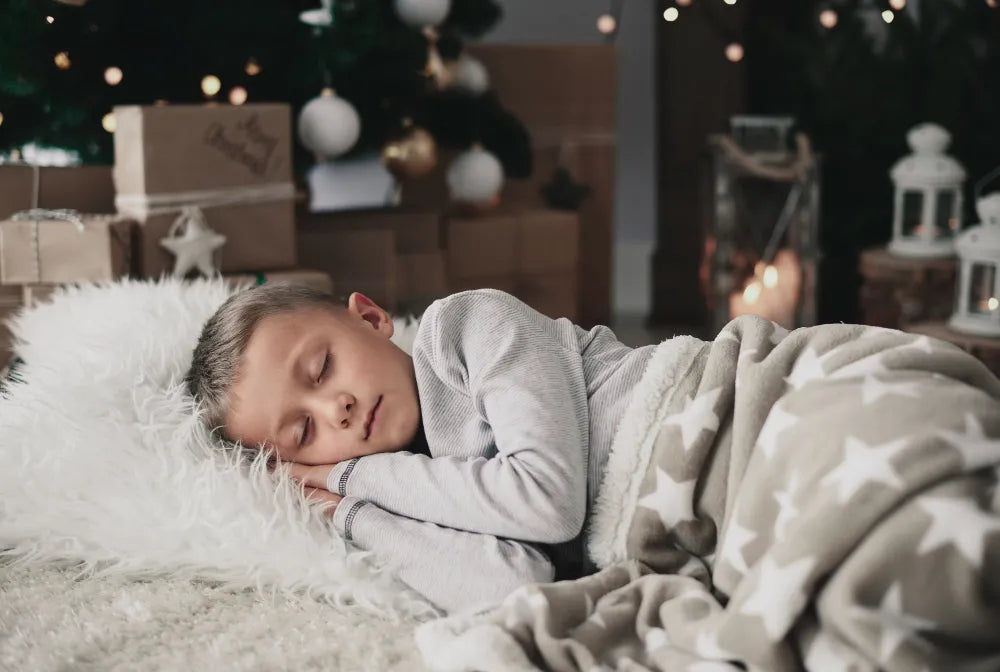Have you ever found yourself standing next to your baby’s crib, wondering if they are warm and cozy enough to sleep safely all night?
It might surprise you, but dressing your baby the wrong way can mess with their sleep and even lead to safety concerns.
As per the guidelines of the American Academy of Pediatrics, it is important to maintain the right sleep temperature as it reduces the risk of Sudden Infant Death Syndrome (SIDS).
That is why it is so important to dress your baby in a way that keeps them both safe and comfortable especially when the weather changes.
This simple guide will walk you through easy tips on how to dress your baby for sleep so you can feel confident and relaxed no matter the season.
Why Choosing the Right Infant Sleep Clothing Matters

Choosing the right sleep clothes for your baby is really important because babies cannot control their body temperature very well on their own.
When dressing a baby for sleep in the right way, it can make a big difference, such as:
-
Keeps Your Baby Safe: The right clothing helps prevent overheating, which lowers the risk of Sudden Infant Death Syndrome (SIDS).
- Helps Your Baby Sleep Better: Comfortable sleepwear can lead to deeper, more peaceful sleep.
-
Maintains the Right Body Temperature: Breathable fabrics help your baby stay warm without getting too hot.
-
Makes Sleep More Comfortable: Soft, snug clothes help your baby feel cozy and secure.
Always choose sleepwear that fits well, allows the skin to breathe, and meets the latest safety guidelines from trusted pediatric experts.
What Are Some Popular Baby Sleepwear Options?
Picking the right newborn sleep clothes is an important step in keeping them safe, cozy, and comfortable all night. Below are some trusted and popular options that many parents rely on for bedtime:
Bodysuits (Onesies)
These one-piece outfits fit close to the skin and can be used as a base layer or worn on their own, depending on the room temperature.
Footed Pajamas (Sleepers)
A classic pick, these pajamas come with built-in feet to help little ones stay warm from head to toe during sleep.
Sleep Sacks (Wearable Blankets)
Instead of loose blankets, many parents choose sleeveless, zip-up sleep sacks that provide gentle warmth and allow your baby to move safely.
Swaddles
Specially designed blankets that wrap securely around newborns to provide comfort and limit startle reflexes.
Two-Piece Pajama Sets
Soft tops and pants are designed for older infants and toddlers who no longer need swaddling.
Gowns
Long, loose-fitting sleepwear with an open or elastic bottom for easy diaper changes, perfect for newborns.
Lightweight Sleepwear
Short-sleeve bodysuits or rompers for warm nights to prevent overheating.
How to Dress Up Your Baby for a Comfortable Sleep in Each Season
As the weather shifts throughout the year, making the right sleepwear choices helps your baby stay comfortable through every seasonal change.
Here is a simple baby sleepwear guide to dressing your baby just right, whether it is spring breezes or winter chills.
Spring
Spring nights are often unpredictable, typically ranging between 65°F–72°F.
Lightweight cotton or bamboo pajamas combined with a breathable sleep sack are ideal. A long-sleeve onesie under a cotton sleep sack can be a good choice.
Summer
Dress your baby in lightweight and breathable fabrics like cotton or bamboo during the hot summer months when the temperature is (above 75°F).
Keep clothing minimal; short-sleeved bodysuits or onesies. Regularly check for overheating signs, such as sweating or flushed skin.
Fall
As fall brings cooler evenings (60°F–68°F), the baby's sleep layers increase gradually.
Consider footed pajamas, which are paired with a medium-weight sleep sack. This combination ensures warmth without overheating.
Winter
Winter requires careful layering to maintain warmth without overheating.
Opt for fleece-footed pajamas paired with a thick, insulated sleep sack when temperatures drop below 60°F. Never use loose blankets or heavy quilts, as they pose a suffocation risk.
What Is the Room Temperature Guideline for Baby Sleepwear?

Babies can lose or gain heat much quicker than adults because their bodies are smaller and they cannot control their temperature as well. That is why it is so important to dress them just right for sleep.
One easy way to do this is by using a temperature guide for baby clothes. It shows you what your baby should wear based on the room’s temperature. For example, a room between 68°F and 72°F is usually perfect for baby sleep.
Here are a few signs to help you tell if your baby is too hot or too cold:
Signs of Overheating in Babies
- Warm or hot chest, neck, or back when touched
- Damp or sweaty skin or hair
- Flushed cheeks or face
- Rapid breathing or increased heart rate
- Restlessness or excessive crying
- Heat rash or red patches on the skin
- The baby appears lethargic or unusually drowsy.
Signs Your Baby May Be Too Cold
- Cool or cold chest, tummy, or back when touched
- Pale, bluish, or mottled skin (especially hands and feet)
- Shivering (though young infants rarely shiver)
- Unusual fussiness or crying
- Hands and feet that feel very cold to the touch (but check core body before adjusting layers)
- The Baby seems difficult to settle or wakes frequently.
What is TOG?
TOG stands for "Thermal Overall Grade." It indicates the level of warmth a fabric provides.
For instance, a sleep sack rated at 1.0 TOG works well in rooms kept between 68 and 75°F, while a 2.0 TOG option is more suitable when the room temperature falls between 61 and 68°F.
TOG ratings help you pick the right sleepwear based on how warm or cool the room is.
A higher TOG rating means the fabric is thicker and warmer—great for cold rooms. A lower TOG rating means the material is lighter and more breathable, which is better for warmer nights.
Here is the breakdown of TOG rating and recommended sleepwear.
|
TOG Rating |
Room Temperature |
Recommended Sleepwear Example |
|
0.2–0.5 TOG |
75°F and above (24°C+) |
Short-sleeve bodysuit or lightweight onesie |
|
1.0 TOG |
69–74°F (21–23°C) |
Onesie with a light sleep sack / Long-sleeve bodysuit |
|
2.5 TOG |
61–68°F (16–20°C) |
Footed pajamas and a medium or thick sleep sack |
|
3.5 TOG |
60°F and below (16°C and under) |
Layered pajamas and a warm, insulated sleep sack |
Baby Sleepwear Safety Tips
- Opt for sleepwear that is either flame-resistant or fits closely to your baby's body to help lower fire risks.
- Look over all clothing for anything that might scratch or irritate your baby, such as scratchy tags, buttons, or rough seams.
- Skip heavy layering. Too many clothes can make your baby too warm and increase the chance of SIDS.
- Replace loose blankets with sleep sacks or wearable blankets to keep your baby safely warm and reduce the chance of suffocation.
- When choosing a sleep sack or swaddle, ensure it fits comfortably. It should be snug enough to provide security but not so tight that it restricts your baby's hips or legs. Your little one should always have enough room to move and stretch naturally.
- Frequently check your baby's pajamas for any loose threads, snaps, or broken zippers that could come off or cause discomfort.
- Leave your baby's head and face uncovered while they sleep since covering them may lead to overheating.
- Pay attention to the nursery's temperature, and add or remove layers as needed to keep the room between 68°F and 72°F (20°C–22°C).
- Feel your baby's chest or neck regularly by touching it with your hands. It should not feel excessively hot or cold. Rather, it should feel comfortably warm.
- Steer clear of any bedding, hats, or heavy blankets in the crib to avoid suffocation risks.
- Skip outfits with drawstrings, hoods, or any extras that could wrap around or choke your baby.
- For added safety, keep your baby's crib in your room during the first six months of life.
- Keep an eye out for signs your baby is getting too warm, such as flushed skin, sweating, or rapid breathing, and adjust layers as needed.
Conclusion
Trusting your instincts and regularly checking your baby's comfort is vital. Use a temperature guide to dress newborn for sleep and easily adjust layers as seasons change.
Dressing a baby for sleep is about balancing comfort and safety. It helps ensure a restful sleep for both of you.
Remember, what works for one child might not work for another. Therefore, it is important to pay attention to the specific cues of your child and adapt as needed.
FAQs
How do I dress a baby to sleep in an air-conditioned room?
You can dress your baby in comfortable footed pajamas or a onesie. You can also add a lightweight sleep sack if the room is cool. Keep the room between 68°F and 72°F, and avoid hats or loose blankets.
Can babies sleep in just a diaper in hot weather?
In very hot conditions (above 75°F), babies can sleep in just a diaper. However, ensure the room temperature remains comfortable and consistent.
How can I know if my baby is too hot or cold?
You should touch your baby's chest or back. It should not feel too hot or too cold. Cold hands or feet may not always indicate discomfort.
When can you stop swaddling or using sleep sacks?
Typically, babies transition out of swaddles around 2–4 months, or once they show signs of rolling. Sleep sacks can be safely used longer, often up to toddler age.


